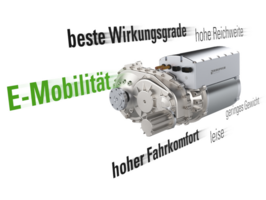Real meets virtual
At HFU, powertrain technology is being rethought − the Powertrain and Machine Validation Laboratory (PMVL) research group led by Prof. Dr. Jäger runs a state-of-the-art Powertrain Technology Laboratory. Both virtual and real analyses of powertrain systems can be carried out here.
The laboratory offers comprehensive learning and research opportunities. Companies can also use the facility for research collaborations and joint projects.
Test rigs and equipment

The key components of the lab are test rigs for the validation of powertrain systems and their components. Both virtual and real studies can be carried out using modern validation methods. The current focus is on efficiency and acoustic behavior.
Powertrain test rig
The test rig features two powerful machines, each with a rated output of 250 kW. With a maximum torque of 11,500 Nm and a nominal torque of 3,500 Nm (at 680 rpm), the machines can be used to simulate driving resistance. The powerful DC source with 250 kW rated power at 730 V/600 A makes it possible to validate a powertrain with a simulated battery.
The system is equipped with real-time capability via EtherCAT and is characterised by a highly modular overall design. This allows different powertrain systems to be analysed. State-of-the-art hardware and software enable the acquisition and processing of extensive measurement data from various sensors (torque, speed, temperature, acceleration)
Gear test rig
The lab also has a test rig for the analysis of gears which has been developed in-house. This is used for high-precision testing of gears for electromobility in order to detect the effects of the smallest modifications to the gear. Measurements include housing vibrations (structure-borne noise) and acoustic behaviour (airborne noise). The test rig also has real-time capability.
Further equipment
The laboratory is also equipped with state-of-the-art measurement technology for carrying out modal analysis to characterise the dynamic vibration behaviour of components. Experimental modal analysis is performed to compare and validate virtual results obtained using the Finite Element Method (FEA). Several acceleration sensors are available for modal analyses, and a number of high-precision measurement microphones and suitable evaluation software are available for acoustic analyses.
Virtual product development
The following investigations in the domain of virtual product development can be carried out in the lab:
- Linear and non-linear structural-mechanical analyses (FEA)
- Dynamic analyses (FEA and MBS)
- Topology optimisation
- Multi-domain simulation of (powertrain) systems (1D simulation)
- Modal and frequency response analyses (FEA and real-experimental validation)
Head of Lab
I am a drive technology specialist. Can I give you more information?



